|
0-DAY REVIOOZ
Looney Tunes Cartoon Conductor (DS)
Or Ouendan Bunny, to give it a more
fitting name. This should be the best thing ever, right? Combine the
awesomeness of two of the DS's defining games (we don't count Elite
Beat Agents here) with classic Warner cartoons and you can't go
wrong, surely? Well, only a bit.
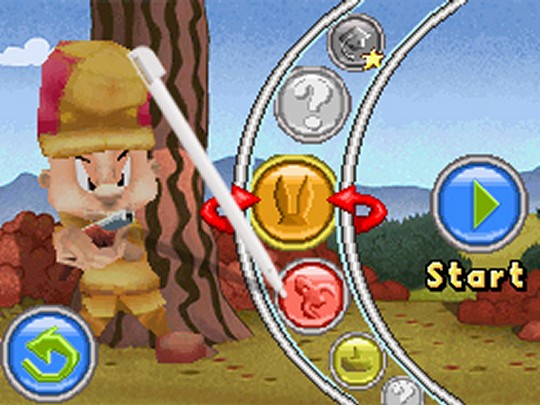
The track-select screen doesn't look like this
preview shot any more. Man!
It starts off abysmally, forcing you
through a tutorial even though you already know how to play bloody
Ouendan, as it's sold a trillion copies everywhere. Hit Start to try
to skip the tutorial and the only options you get are "Quit" (back
to the menu) and "Restart" (back to the start of the tutorial,
hngh). Resist smashing your DS at this point and you eventually find
out that there's a slight tickle to the controls - you have to keep
the stylus on the screen throughout any given sequence (1-2-3-4
etc), though you can lift it between sequences - but nothing that
couldn't have been explained in a line of text. Oh, and there's also
a replacement for Ouendan's disc-spinning sections, where instead
notes fall down the screen and you have to tap them as they hit the
circles at the bottom like an upside-down Dance Dance Revolution,
but that one's incredibly obvious without instruction.
(The restart thing, incidentally, also
applies in-game. So if you get an itchy nose, or drop the stylus, or
have to answer the phone and you hit Start to pause, you're not
actually pausing. The only places to go after that are back to the
song menu or back to the start of the stage you're on, which is so
idiotic it defies all rational sense.)
So grit your teeth and after a couple of minutes you'll get to the
game. Three difficulty levels are available straight away
(Apprentice, Conductor and Maestro), so obviously you start on the
middle one. It's basically classic Ouendan from here on in - beating
tracks unlocks new ones a couple at a time. There are 12 in all,
plus six "remixes", and the music is all classical (in the broader
sense of the word), accompanied by upper-screen interpretations of
favourite LB cartoons like Robin Hood Daffy and Rabbit Of Seville,
portrayed in that annoying polygon style that seems to be de
rigeur for cartoon games, even though it makes no obvious sense
compared to doing them properly in 2D like the originals.
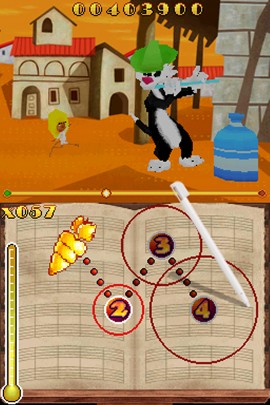 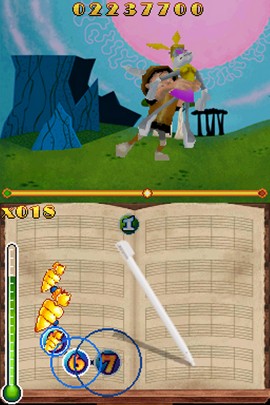
The stylus graphic only appears on the beginner
stages.
The music is splendidly done, with a
full-blooded orchestra for you to conduct along to. (I forgot to
mention that you're playing a conductor. In a nice touch, you have
to triple-tap the screen at the start to get the orchestra's
attention) The selection of tracks, though, is bizarre. For almost
every familiar favourite obviously suited to the game like the
William Tell Overture or Ride Of The Valkyries, there's a godawful
dirge like Mars, The Bringer Of War by Holst, with no obvious tune
and which you have to play entirely visually by following the
shrinking circles and squares. Get to the end (and on medium
difficulty it's a bit more forgiving than Ouendan) and you'll get
applause depending on your rating - a full-blown ovation for an A or
S, one guy sarcastically clapping by himself for a C - and move on.
Beating levels unlocks character bios and various sound samples.
(You can also get a super-elusive S+ rating, incidentally, for which
you'll have to hit EVERY step in a level.)
On the good tunes, LTCC is a sheer joy. The William Tell Overture
brings to mind the joyous sequence in Brassed Off, and you'll be
sweeping the stylus around with glorious flamboyant flourishes like
a pro, while the Mexican Hat Dance of Speedy Gonzales, Foghorn
Leghorn's extract from Carmen, and Barber Of Seville are almost as
enjoyable. And the final song, a staggeringly brutal sequence based
around the Can-Can, is still addictive and fun thanks to the music.
(Cleverly, when you miss a note the orchestra gets it wrong too,
leading to a horrible off-key cacophony that makes you desperate to
rescue the situation, but makes it harder to follow the tune as fair
punishment for your error.)
On the bad stuff, though, it's
absolutely miserable. Whoever thought to accompany the magnificent
kinetic verve of Devil May Hare with the meandering multi-paced mess
of Liszt's Hungarian Rhapsody wants their face kicking off with
running spikes, and Sylvester and Tweety's accompaniment of Bach's
well-known Toccata and Fugue is sheer purgatory, and not what you
might be expecting/hoping for if you remember the famous part of the
tune. Wile E Coyote and Road Runner's stage is mangled too, with a
rendition of Flight Of The Bumble Bee that bears not the slightest
discernible relation to the onscreen steps, and is the worst stage
by a distance.
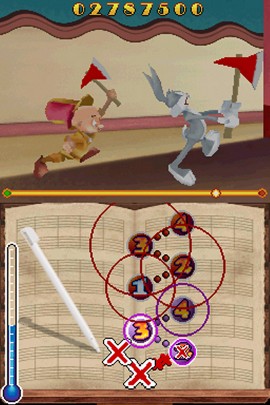 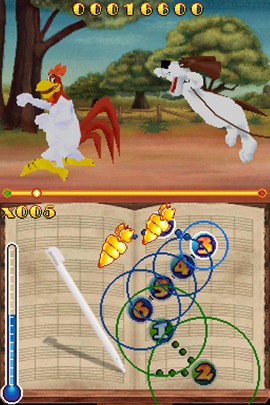
Of the 12 non-remixed tracks, there are
basically seven good ones and five bad.
Worst of all are the "remixes", where
six of the 12 tunes are given utterly horrible modern jazzings-up,
which even to a total classical-music philistine like me are bad
enough to be sacrilegious. Every single one of them is toweringly
awful, ruining even William Tell and the Can-Can, and the game would
have been better with them left out entirely, never mind replaced by
half-a-dozen proper tracks. (At least it picks the better tunes to
ruin, so you don't have to suffer a double whammy of a remixed
"Toccata and Fugue".)
This reviewer zipped through the medium Conductor difficulty level
in not much over an hour (though the Can-Can took a lot of tries)
but with mostly poor ratings, and will be replaying it to get better
ones, at least on the non-remixed tracks. First, though, came the
hard and extreme (unlocked by beating hard) settings, and that's
when things start to get really entertaining. On Maestro, the number
of steps in each bar takes a big jump upwards, which in many ways is
actually a help as it means you don't have to try to figure out
which beats the game's going to put them on - there are so many
they're almost on every note, and it's simply a matter of keeping
track of the blizzard of circles and squares cascading onto the
screen and hitting them in time and in the right order (it's
uncannily similar to the skills required to play the TIE-Fighter
battle in the original Star Wars arcade game).
In Looney mode, however, even the
toughest settings of the Ouendan games look like a walk in the park.
The tidal wave of steps to hit never lets up, requiring not only
memory but the skill to slide across the screen in a split second
without hitting any of the wrong ones. Worse yet, the breaks that
are present in the other difficulty levels - where you get a few
seconds of respite to stop, wipe your palms, gather your thoughts
and watch the upper-screen cartoon - are cruelly discarded, with the
barrage of steps continuous from start to finish, often requiring
machine-gun-like speed and with the effect of a bum note absolutely
catastrophic to your chances of finding your place again. Beat a
Looney level, though, and the sense of exhilaration is absolutely
huge - you'll want to save the replay and watch it over and over.
(Bizarrely you get 11 save slots, one too few to save your best run
on each of the different tunes.) And on both Maestro and
Looney, you'll be so busy trying to hit the steps that you'll hardly
notice how terrible the remixed tracks are, which is a welcome
bonus.
It's great to finally have a version
of Ouendan in English that isn't entirely comprised of totally awful
songs, and LTCC is a subtly different ripoff that with its
orchestral trappings successfully manages to create a character all
of its own. Beating the levels, and then getting A and S ratings on
the good ones, will occupy you for many very happy hours. Like
Looney Tunes? Like Ouendan? Then this will only disappoint you
occasionally, making it automatically the best Looney Tunes
videogame of all time.

|